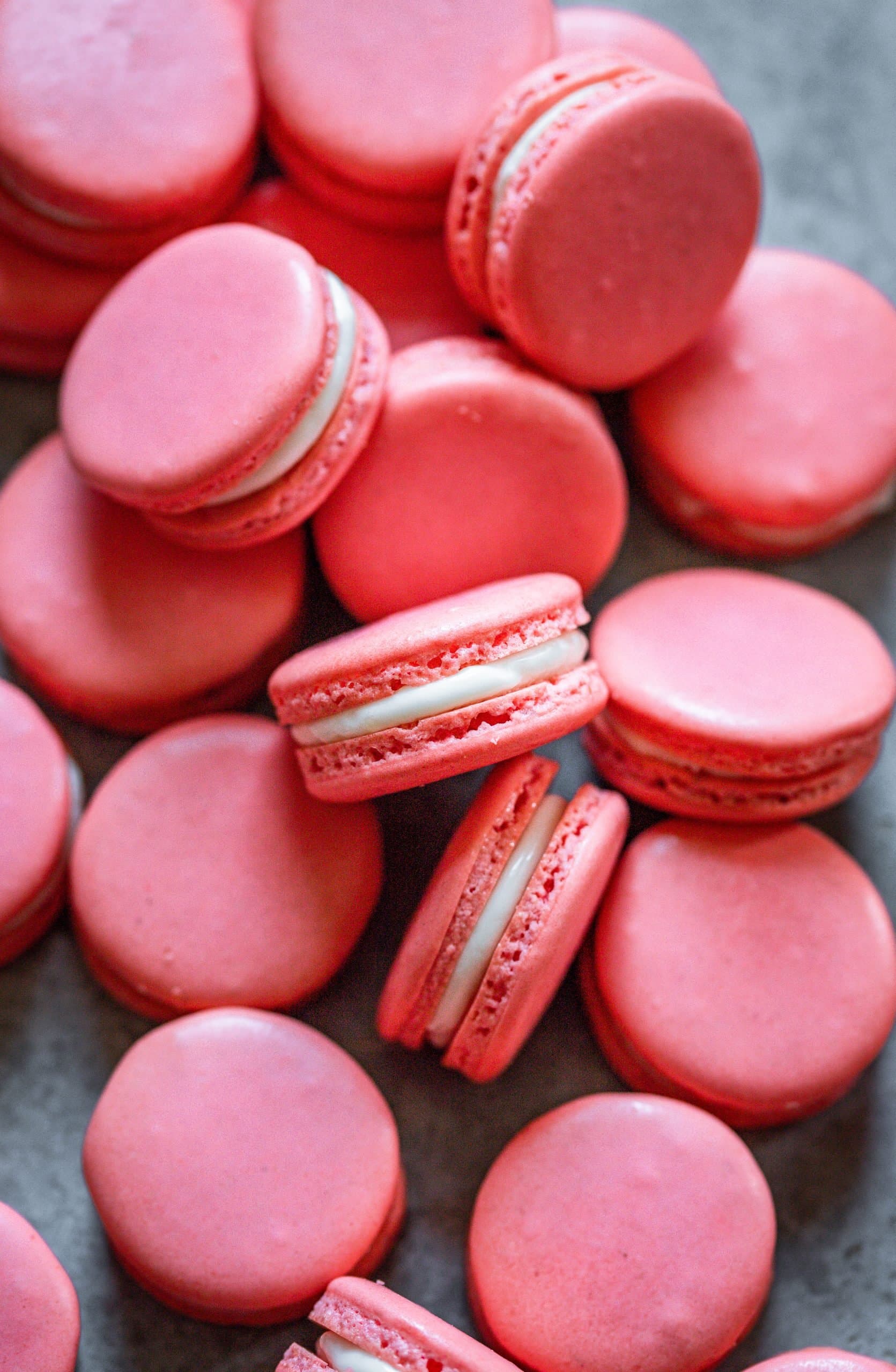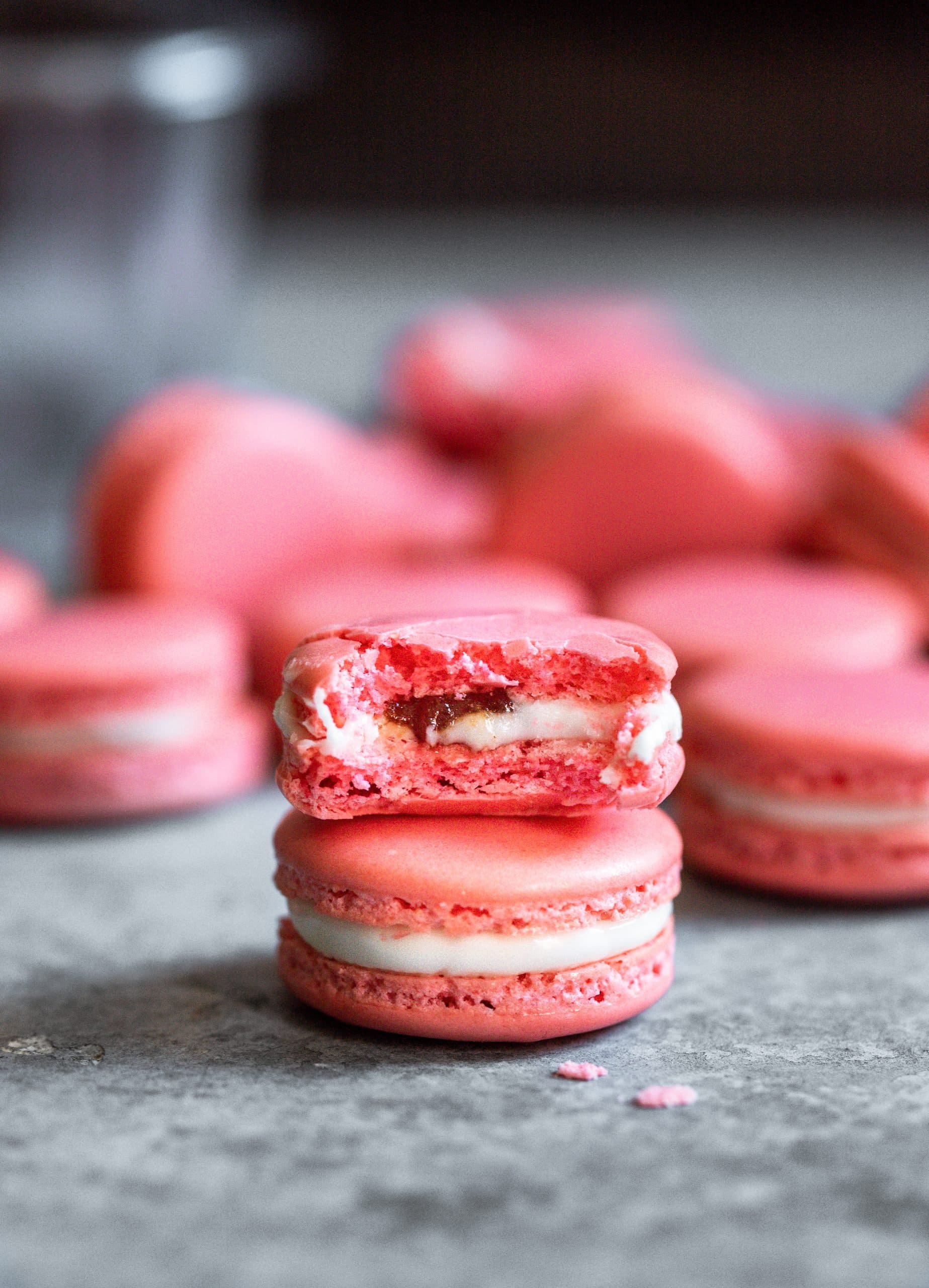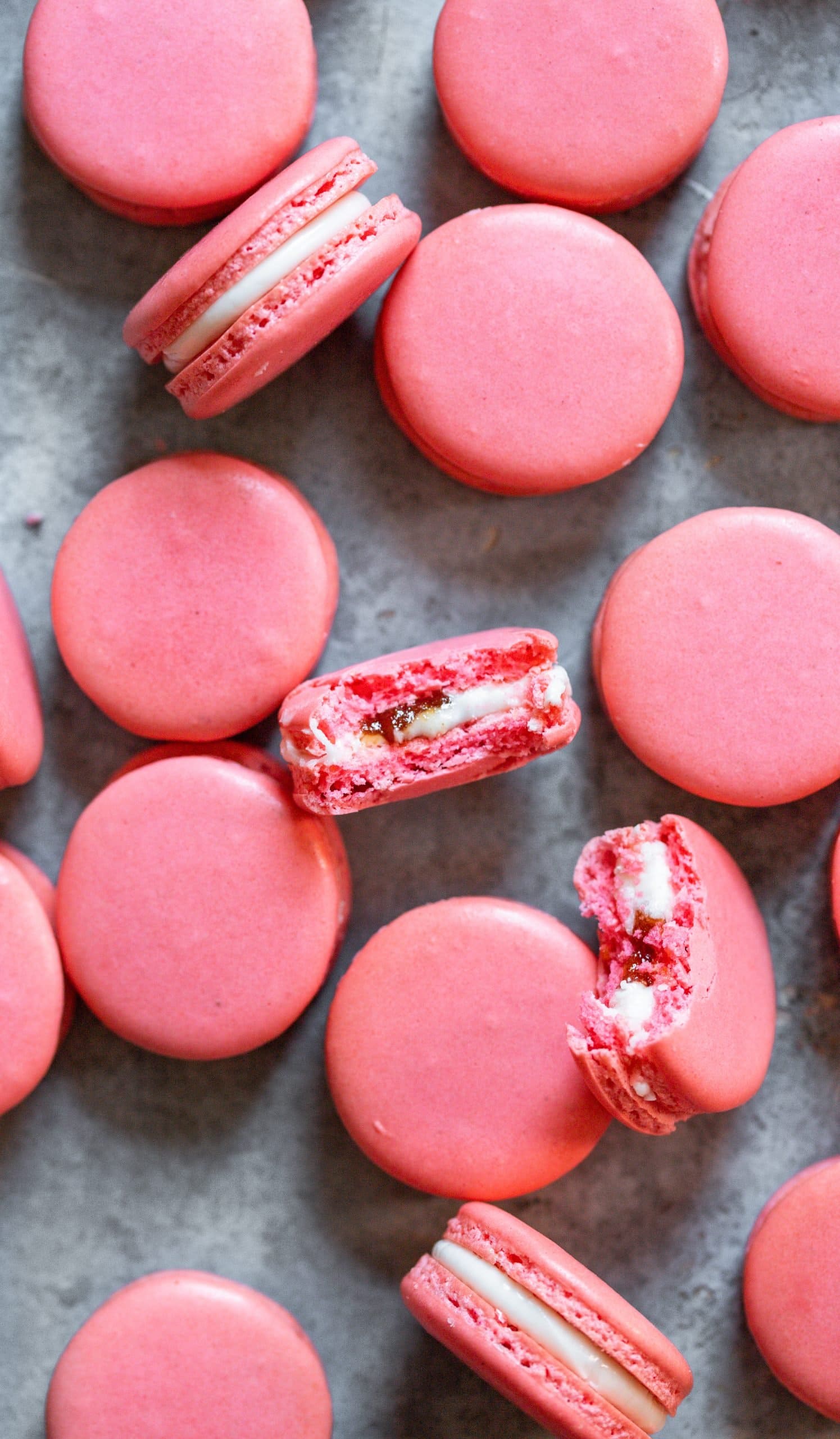This post may contain affiliate links. Read my Disclosure page.
Table of contents

Guava & Cheese Macarons
If you're reading this, you probably fall into one of two categories: 1) OMG guava & cheese macarons? REALLY!? ? or 2) Guava... and cheese...? ?
If you're in category #1, the answer is YES, and you should click that little 'jump to recipe' button at the top of the post to start making these ASAP because you already know!
If you're in category #2, the answer is still YES, but let me explain...
These macarons are inspired by pastelitos de guayaba y queso, which are Cuban pastries (or turnovers) made with puff pastry and filled with guava paste and cream cheese. With pastelitos being deliciously easy to make, I figured why not stuff those flavors into something you normally wouldn't see... and thus these macarons were born.
As we all know, macarons can be tricky to make... and if you find that you've been too intimidated to try OR you have tried but they failed horribly, I suggest you read my lengthy post on the subject: The Ultimate French Macaron Guide.
How to Make Guava & Cheese Macarons
This recipe starts with my basic macaron shell; I used Americolor's Dusty Rose gel coloring to get the shells guava-esque in color.
Sandwiched between the macaron shells? Cream cheese, of course. Smooth, slightly sweetened cream cheese. And then there's a guava filling (made from guava paste) right in the center. The entire macaron, the sweet, delicate shells, and creamy guava & cheese filling will just melt in your mouth.

What is Guava Paste?
Guava paste is a really thick, dense puree of guava that has been cooked down with sugar. It can be sliced into chunks and is a bit thicker and less gelatinous than say jellied cranberry sauce.
Guava paste typically comes either in cans or sometimes in little bricks wrapped in plastic and can usually be found in Latin food aisles or even on Amazon.
It’s used a lot in Cuban, Caribbean, and some South American cuisines and tastes very tropical, intensely fruity, and almost subtly floral, sort of like a cross between a strawberry and a pear, but with a distinct, exotic quality.

Tips to Make the Perfect Guava & Cheese Macarons:
- An extensive list of macaron tips can be found at the bottom of my Ultimate French Macaron Guide. (Click 'jump to recipe' and scroll up)
- Avoid using liquid food coloring for the macaron shells, as it will disrupt the texture of your batter.
- Double up on sheet pans when baking. Preheat an empty sheet pan in the oven; once your macarons are ready to bake, place the pan with the rested macaron shells on top of the preheated pan in the oven. This helps keep the distribution of heat even and can help prevent hollow shells.
I hope you enjoy these guava & cheese macarons just as much as I do. Which is, like, A LOT.
Find more macaron flavors here!
Guava & Cheese Macarons
Ingredients
For the Macarons:
- 120 grams almond flour
- 120 grams powdered sugar
- 100 grams egg whites (approx. 3 large eggs) room temperature
- 100 grams granulated sugar
- Pink gel food coloring (do NOT use liquid coloring)
For the Guava Filling:
- 55 g guava paste
- 30 g water
- 1 teaspoon lemon juice
For the Cream Cheese Filling:
- 115 g cream cheese room temperature
- 240 g powdered sugar
- 1 teaspoon milk
Instructions
To Make the Macarons:
- In a medium bowl, sift together the almond flour & powdered sugar and set aside.
- In the bowl of a stand mixer fitted with the whisk attachment, whip the egg whites on medium speed until foamy. Continue to beat until your whisk begins leaving visible trails in the foamy egg whites.
- Once you can see trails, gradually add the granulated sugar, increase the mixer speed, and whip on medium-high until the meringue forms. Add pink gel food coloring, if using, then beat on high until stiff peaks form. (Be sure not to over-whip your egg whites otherwise you risk drying them out.)
- Remove the bowl from the stand mixer, add the dry ingredients to the meringue and fold with a rubber spatula from the bottom of the bowl upward then press the flat side of your spatula through the middle against the side of the bowl. (The batter will look very thick at first, but it will get thinner as you fold.) Continue folding until the batter gets to a lava-like consistency.Pro Tip: The figure 8 test is a great way to check your batter’s consistency; pick up the batter with your spatula and let it flow down into the bowl while drawing the figure “8”. If it can do that without the batter breaking, immediately stop folding.
- Transfer the batter into a large pastry bag with a medium-sized round tip.
- Holding the piping bag at a 90 ̊ angle to the surface, pipe out the batter into 1.5-inch rounds about an inch apart on a baking sheet lined with parchment paper. (Feel free to print out a macaron template if you’re worried about size/uniformity).
- Holding the baking sheet with both hands, carefully bang the sheet firmly on the counter a few times to get rid of any air bubbles. (If you don’t release the air bubbles, they will expand during baking and crack your macaron shells.)
- Repeat the piping and banging process until you have used up all the batter (usually about three sheet pans worth.)
- Let the macarons rest and dry for 30 minutes or until a skin has developed; on a humid day, it might take an hour or more. To see if they're ready to be baked, lightly touch the shells. If the batter doesn’t stick to your finger, then it’s ready. (Don’t forget to remove the macaron templates, if using, before baking!)
- While the macarons are resting, preheat the oven to 300˚F (150˚C) and position the oven rack in the center of the oven.
- Bake the macarons, one tray at a time, for 18-20 minutes, rotating the pan once halfway through the baking process.
- Remove from the oven and allow to cool on the sheet pan for 10 minutes before peeling off the parchment paper and cooling completely on a wire rack. (If the bottoms are a tiny bit sticky, keep them on the tray to cool off for an additional 10-15 minutes. If, however, the bottoms are already brown, they peel off cleanly, or they appear over-baked, then carefully take them off the tray immediately to cool down.) Repeat the baking process with the remaining sheet pans.Pro Tip: It’s always better to over- rather than under-bake your macarons as the maturation process can typically salvage ones that are over-baked.
To Make the Guava Filling:
- In a small saucepan over medium-low heat, add the guava paste, water, and lemon juice and cook, stirring often, until the guava paste begins to loosen up.
- Stir and mash the guava paste into smaller chunks and continue to cook until it becomes the consistency of jam. Remove from the heat and set aside to cool.
To Make the Cream Cheese Filling:
- In the bowl of a stand mixer fitted with the paddle attachment, or in a large bowl with an electric mixer, beat the cream cheese on medium-high speed until creamy, about 2 minutes.
- Add the powdered sugar and milk and beat until well combined. Turn the mixer back up to medium-high speed and beat the mixture for an additional 2 minutes until the cream cheese filling is fluffy. If needed, add in a little more milk 1 teaspoon at a time until you reach your desired consistency. If the buttercream is too runny, add additional powdered sugar 1 tablespoon at a time. Transfer the cream cheese filling into a pastry bag.
Assembly:
- Place the guava filling into a small piping bag fitted with a round tip. Pair each macaron shell with another of a similar size and place the shells on a baking sheet. Pipe a ring of cream cheese on one shell, then a blob of guava in the middle. Place the second shell on top, gently sandwiching together. Repeat with the remaining macarons. Store the filled macarons in an airtight container in the fridge for up to 5 days and bring back to room temperature before enjoying.
Notes
- Macarons are best enjoyed the next day after they mature in the fridge (since the flavors will be absorbed into the shell). If your shell is hard/crunchy/over-baked, letting them mature will also cause the shells to absorb the moisture from the filling and soften up / give them their signature chewy texture.


KC
I am so excited I found your site! I was searching for mac-n-cheese balls and the search brought up your 5 star recipe. BUT now this recipe makes me happy and I cannot wait to try these guava and cheese macarons. I actually thought about making guava filling for macarons about a year ago. I bought the paste then never really took the time to figure it out. So......Thank you for figuring it out. I'll be buying the ingredients and trying these over the next week or two. One of my fave fillings I have made for macarons has been a homemade rhubarb filling with a lightly sweetened vanilla swiss meringue buttercream. The rhubarb tang with the lightly sweetened silky buttercream was really yummy!
Farida
Super Super amazing idea for macaron filling...